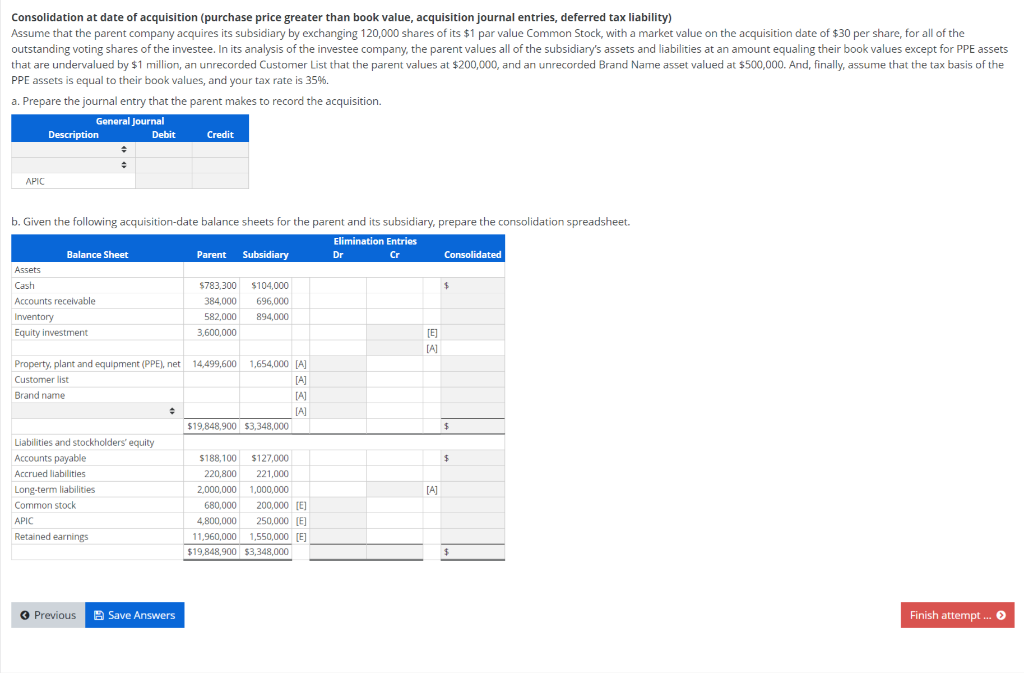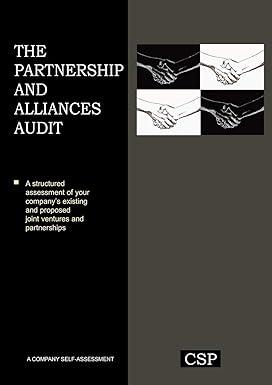
Consolidation at date of acquisition (purchase price greater than book value, acquisition journal entries, deferred tax liability) Assume that the parent company acquires its subsidiary by exchanging 120,000 shares of its $1 par value Common Stock, with a market value on the acquisition date of $30 per share, for all of the outstanding voting shares of the investee. In its analysis of the investee company, the parent values all of the subsidiary's assets and liabilities at an amount equaling their book values except for PPE assets that are undervalued by $1 million, an unrecorded Customer List that the parent values at $200,000, and an unrecorded Brand Name asset valued at $500,000. And, finally, assume that the tax basis of the PPE assets is equal to their book values, and your tax rate is 35%. a. Prepare the journal entry that the parent makes to record the acquisition. General Journal Description Debit Credit APIC b. Given the following acquisition-date balance sheets for the parent and its subsidiary, prepare the consolidation spreadsheet. Elimination Entries Balance Sheet Parent Subsidiary Dr Cr Consolidated Assets Cash $783.300 $104,000 $ Accounts receivable 384,000 696,000 Inventory 582,000 894,000 Equity investment 3,600,000 [E] [A] Property, plant and equipment (PPE), net 14,499,600 1,654,000 (A) Customer list [A] Brand name [A] IA $19,848,900 $3,348,000 $ Liabilities and stockholders' equity Accounts payable $188,100 $127,000 $ Accrued liabilities 220,800 221,000 Long-term liabilities 2,000,000 1,000,000 [A] Common stock 680,000 200,000 [E] APIC 4,800,000 250,000 (E) Retained earnings 11,960,000 1,550,000 [E] $19,848,900 $3,348,000 $ Previous Save Answers Finish attempt ... > Consolidation at date of acquisition (purchase price greater than book value, acquisition journal entries, deferred tax liability) Assume that the parent company acquires its subsidiary by exchanging 120,000 shares of its $1 par value Common Stock, with a market value on the acquisition date of $30 per share, for all of the outstanding voting shares of the investee. In its analysis of the investee company, the parent values all of the subsidiary's assets and liabilities at an amount equaling their book values except for PPE assets that are undervalued by $1 million, an unrecorded Customer List that the parent values at $200,000, and an unrecorded Brand Name asset valued at $500,000. And, finally, assume that the tax basis of the PPE assets is equal to their book values, and your tax rate is 35%. a. Prepare the journal entry that the parent makes to record the acquisition. General Journal Description Debit Credit APIC b. Given the following acquisition-date balance sheets for the parent and its subsidiary, prepare the consolidation spreadsheet. Elimination Entries Balance Sheet Parent Subsidiary Dr Cr Consolidated Assets Cash $783.300 $104,000 $ Accounts receivable 384,000 696,000 Inventory 582,000 894,000 Equity investment 3,600,000 [E] [A] Property, plant and equipment (PPE), net 14,499,600 1,654,000 (A) Customer list [A] Brand name [A] IA $19,848,900 $3,348,000 $ Liabilities and stockholders' equity Accounts payable $188,100 $127,000 $ Accrued liabilities 220,800 221,000 Long-term liabilities 2,000,000 1,000,000 [A] Common stock 680,000 200,000 [E] APIC 4,800,000 250,000 (E) Retained earnings 11,960,000 1,550,000 [E] $19,848,900 $3,348,000 $ Previous Save Answers Finish attempt ... >







